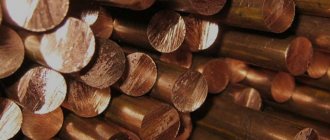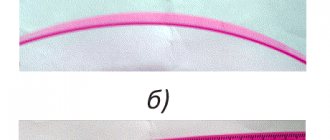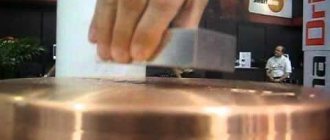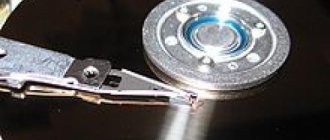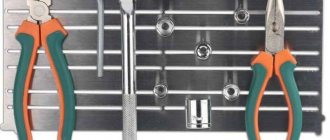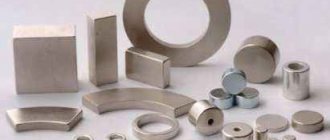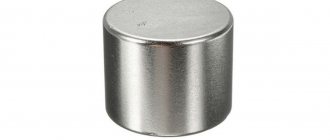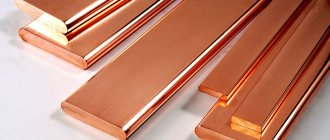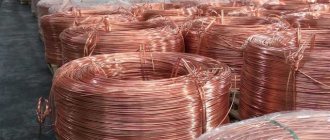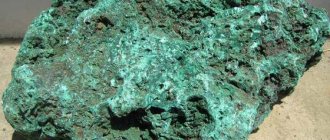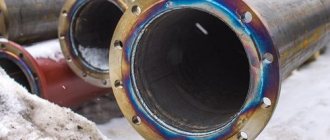Sometimes it happens that it is necessary to determine what metal or alloy a coin is made of. The first thing that comes to mind is to pay attention to its color. But then it turns out that, for example, a yellow coin can be made of copper, brass, nickel-copper alloy, or other material. How then? A common testing method is to use a magnet. But for this you need to know whether copper is magnetic or not.
Copper is not magnetic
Magnetic properties
Each atom has a quantity called a total magnetic moment, which is determined by the movement of electrons along their orbit. The magnetic moment determines the amount of susceptibility of a substance to a magnetic field. All metals are divided into three groups:
- Diamagnets are substances with negative magnetic susceptibility, i.e. they do not magnetize. These include: zinc, gold, copper and others.
- Paramagnetic materials have a positive magnetic susceptibility value, but not high. These are magnesium, platinum, chromium, aluminum and others. They are magnetic, but weakly.
- Ferromagnets are substances that have a strong susceptibility to a magnetic field. These include: nickel, cobalt, iron, some rare earth metals, iron alloys and others.
Copper in the periodic table
Table
The difference between aluminum and copper can be seen in the table below.
| Copper | Aluminum | |
| "Experience" of human use | 6-7 thousand years | Since 1825 |
| Main Applications | Electrical engineering, production of quality pipes, some other industries | Electrical engineering, aircraft construction, creation of light load-bearing structures (alloys), food industry, other industries |
| Density | 8.92 g/cm3 | 2.6989 g/cm3 |
| Electrical conductivity (at 20 °C) | 59500000 cm/m | 38000000 cm/m |
| Melting temperature | +1356 °C | +660 °С |
Alloys and their magnetic properties
Copper is not magnetic. If you still come across a coin that looks like copper, but has magnetic properties, then most likely it is an alloy. In such an alloy there will be no more than 50% copper. This can be done on purpose, but there have been cases when copper exhibited magnetic properties that was not cleared of impurities during the coin making process.
Every person needs at least minimal knowledge about the magnetic properties of metals. In most cases, this is enough to determine copper - the copper product will not stick to the magnet.
Any child knows that metals are attracted to magnets. After all, they have more than once hung magnets on the metal door of the refrigerator or letters with magnets on a special board. However, if you put a spoon against a magnet, there will be no attraction. But the spoon is also metal, so why does this happen? So, let's find out which metals are not magnetic.
Paramagnets and ferromagnets
Let's consider the option when each atom of a substance has its own magnetic field. These fields are multidirectional and compensate each other. If you place a magnet next to such a substance, the fields will be oriented in one direction. The substance will have a magnetic field, a positive and a negative pole. Then the substance will be attracted to the magnet and can itself become magnetized, that is, it will attract other metal objects. For example, you can magnetize steel clips at home. Each one will have a negative and a positive pole, and you can even hang a whole chain of paper clips on a magnet. Such substances are called paramagnetic.
Ferromagnets are a small group of substances that are attracted to magnets and are easily magnetized even in a weak field.
Diamagnets
In diamagnetic materials, the magnetic fields inside each atom are compensated. In this case, when a substance is introduced into a magnetic field, the movement of electrons under the influence of the field will be added to the natural movement of electrons. This movement of electrons will cause an additional current, the magnetic field of which will be directed against the external field. Therefore, the diamagnetic material will be weakly repelled from the nearby magnet.
So, if we approach the question from a scientific point of view, which metals are not magnetic, the answer will be – diamagnetic.
Distribution of paramagnets and diamagnets in the periodic table of Mendeleev elements
The magnetic properties of simple substances change periodically with increasing atomic number of the element.
Substances that are not attracted to magnets (diamagnets) are located mainly in short periods - 1, 2, 3. Which metals are not magnetic? These are lithium and beryllium, and sodium, magnesium and aluminum are already classified as paramagnetic.
Substances that are attracted to magnets (paramagnets) are located mainly in the long periods of the Mendeleev periodic system - 4, 5, 6, 7.
However, the last 8 elements in each long period are also diamagnetic.
In addition, three elements are distinguished - carbon, oxygen and tin, the magnetic properties of which are different for different allotropic modifications.
What metals are not magnetic: list
There are only 9 ferromagnets, that is, metals that are highly magnetic, in nature. These are iron, cobalt, nickel, their alloys and compounds, as well as six lanthanide metals: gadolinium, terbium, dysprosium, holmium, erbium and thulium.
Metals that are attracted only to very strong magnets (paramagnetic): aluminum, copper, platinum, uranium.
Since in everyday life there are no such large magnets that would attract a paramagnetic material, and also no lanthanide metals are found, we can safely say that all metals except iron, cobalt, nickel and their alloys will not be attracted to magnets.
So, what metals are not magnetic to a magnet:
- paramagnetic materials: aluminum, platinum, chromium, magnesium, tungsten;
- diamagnetic materials: copper, gold, silver, zinc, mercury, cadmium, zirconium.
In general, we can say that ferrous metals are attracted to a magnet, non-ferrous metals are not.
If we talk about alloys, then iron alloys are magnetic. These primarily include steel and cast iron. Precious coins can also be attracted to a magnet, since they are not made of pure non-ferrous metal, but of an alloy that may contain a small amount of ferromagnetic material. But jewelry made of pure non-ferrous metal will not be attracted to a magnet.
What metals do not rust and are not magnetic? These are ordinary food grade stainless steel, gold and silver items.
Sometimes at home you need to distinguish copper from another metal, and also check the cleanliness of a copper product and whether there are any foreign impurities in it. This can be done based on the appearance of the metal, as well as on determining its properties, in particular, by conducting a test with a magnet.
Search data for your request:
Sometimes at home you need to distinguish copper from another metal, and also check the cleanliness of a copper product and whether there are any foreign impurities in it. This can be done based on the appearance of the metal, as well as on determining its properties, in particular, by conducting a test with a magnet.
Cuprum copper is a metal that has a golden-reddish color and is characterized by high thermal and electrical conductivity. Another distinctive quality of the element is its high ductility. Nuggets are found less and less often in nature; they are most often mined from ore.
When determining the authenticity and purity of a sample, you can turn to an expert, but determining a chemical element in a laboratory is quite expensive.
Search data for your request:
Schemes, reference books, datasheets: Discussions, articles, manuals:
Wait for the search to complete in all databases. Upon completion, a link will appear to access the found materials.
WATCH THE VIDEO ON THE TOPIC: Types of magnets. Why aren't all metals attracted to magnets? all-audio.pro-14 issue
Is copper magnetic or not?
Magnets come in completely different shapes. The most famous shapes are bars, cylinders, discs, rings and, of course, in the form of a horseshoe.
Magnets can be as big as a car or as small as a pinhead. The size of a magnet is not a good indicator of its strength.
For example, a tiny neodymium magnet can be incredibly powerful, capable of holding an object many times its own weight.
Magnets attract some materials. Materials that are attracted by a magnet are called magnetic materials. These include iron, cobalt, nickel and some rare earth elements.
It should be noted that all these materials are metals, but not all metals are magnetic materials. Aluminum, copper, lead, gold and silver are metals that are not attracted to a magnet.
Materials that are not attracted to a magnet are called non-magnetic materials.
A test of whether an object is a magnet or not is to see whether some part of the object can be repelled by some part of a known magnet. These poles are called the south S and north N poles.
The poles can be located at any point on the magnet: near the ends of the magnet, on opposite surfaces, and even on the edges.
In addition, a magnet can have more than one pole of each type - it all depends on the configuration of the magnetizing installation.
The pole of a free-standing magnet that points towards the North is called the magnetic north pole; the pole that points south is called the south magnetic pole.
If you hang a light magnet in the form of a bar with magnetized ends on a thread, the magnet will start moving and stop only when one of the ends points in the direction of the geographic North - this end of the pole of the magnet is called the north pole.
The opposite pole is called the south pole. The compass needle is a free-standing magnet. Most types of compasses have various markings on the needle that indicate which end is the north pole.
Typically one half of the hand is colored to indicate the north pole. But be careful: sometimes the poles of the compass needle are unintentionally reversed. In order to use the compass, you need to wait until the compass needle stops. The colored end of the arrow should point to geographic North.
You can now look at the compass to determine the directions North, East, South and West. The circumference of a compass is usually divided into equal parts, known as degrees. Compass measurements usually start at 0 degrees, which is North. Then East is 90 degrees, South is degrees and West is degrees.
North is both 0 and degrees. When using a compass, make sure there are no magnets or magnetic materials nearby that could affect the direction of the compass needle. Our planet Earth acts like a magnet. The compass needle behaves as described above because the Earth is a huge, weak magnet.
Like other magnets, the Earth has a north magnetic pole and a south magnetic pole. The strength of the Earth's magnetic field is 0.3 Gauss near the equator and 0.7 Gauss near the poles. Although these are very weak fields, they are easily detected by a compass. The Earth's magnetic poles are close to, but do not coincide with, the geographic poles.
The magnetic pole in the northern hemisphere is located on Bathurst Island in the northernmost part of Canada, at a distance of about km from the geographic pole of the Earth.
This pole is actually the south magnetic pole, although located in the North.
The magnetic pole in the southern hemisphere is located on Wilkes Land in Antarctica, about km from the geographic south pole of the Earth and is actually the magnetic north pole.
Terrestrial magnetism manifests itself due to the presence of charged particles in the moving liquid core of the Earth. There is evidence that at certain periods of history the Earth's magnetic poles were opposite to their current location and even sometimes disappeared completely for certain periods of time. If you place two magnets next to each other, they begin to interact with each other.
This phenomenon is called the law of magnetic poles. A magnet has its greatest strength at its poles. The greatest strength of a magnet is found at its poles, and this strength decreases rapidly with increasing distance from the pole.
At a point located exactly midway between the two poles of a strip magnet. Encyclopedia of Magnetism. Magnets come in different sizes, shapes and strengths. A magnet can either attract or repel another magnet. All magnets have two types of poles.
The compass needle is a magnet.
Like poles repel; different poles attract.
Why is copper not magnetic?
Melchior, corrupted from French. Previously, cupronickel meant not only copper-nickel alloys, but also alloys of copper with nickel and zinc, nickel silver, as well as silver-plated brass, which is why products made from these materials are often called cupronickel.
Alloys such as cupronickel are solid solutions, so they work well in cold and hot states. Cupronickel is characterized by high corrosion resistance in fresh and sea water, dry gases, as well as in atmospheric conditions.
As the nickel content increases, corrosion resistance and strength increase.
Why copper coins are magnetic - sent to Numismatics: Many forum users have heard, and some have checked and become convinced.
Is copper magnetic?
Sometimes it happens that it is necessary to determine what metal or alloy a coin is made of. The first thing that comes to mind is to pay attention to its color. But then it turns out that, for example, a yellow coin can be made of copper, brass, nickel-copper alloy, or other material.
How then? A common testing method is to use a magnet. But for this you need to know whether copper is magnetic or not. Each atom has a quantity called a total magnetic moment, which is determined by the movement of electrons along their orbit. The magnetic moment determines the amount of susceptibility of a substance to a magnetic field.
All metals are divided into three groups:.
Is copper magnetic?
My daughter just loves magnets! At some point, her love for them became simply enormous. She could spend 20 minutes rearranging the souvenir magnets on our refrigerator. I decided that if I did it this way it would be useful. And I bought her a bunch of cheap children’s magnets from Drofa-Media
Magnets come in completely different shapes.
Copper-nickel alloys
Recycled materials can be reused after processing. To find out what the price of copper scrap per kg is today, contact our manager by phone or online. All consultations are free.
If you have another non-ferrous metal or ferrous metal, find out what the price for machines for scrap metal is, where the collection points are located in Moscow and how to order the removal service for a large batch.
The increase in prices for the purchase of scrap at collection points allows owners of unnecessary secondary raw materials to receive a stable income and provide production with non-ferrous metal.
Why is copper magnetic?
Hello, not long ago I watched a video on YouTube about how they checked extension cords, tees, surge protectors, etc. The contact group on Soviet devices was not magnetic, but on the current ones, almost all of them are magnetic. And it was said that if it is not magnetic, then it is either brass or copper, and if it is magnetic, then it is steel or some kind of repainted metal.
I checked almost all the extension cords at home this way - some are magnetic, some are not. There is no difference in performance, everything seems to be fine, both in the first case and in the second.
Actually, the question is - how bad is it? What can be affected during operation? And in general, is it worth bothering yourself if everything works like that, otherwise these electrical appliances probably wouldn’t be produced?
And it was said that if it is not magnetic, then it is either brass or copper, and if it is magnetic, then it is steel or some kind of repainted one.
From time immemorial, gold has been and was considered a special metal, with its own unique properties and, so to speak, abilities. But you can often hear that this metal is good at magnetism - how realistic is this and does it correspond to the characteristics of the metal? Gold in its pure form has a sample where on gr.
The organization buys steel pipes on an ongoing basis. I will buy a used circle, pipe, forging sheet, steel. The organization purchases brass and copper scrap, metal from the state reserve. As well as scrap aluminum of groups 1 and 2.
The eyes are also a tool. And this tool needs to be kept in order and periodically restored, or even sharpened. The eyes have enough... We expect our illusions to be realized through someone, but they don’t realize it and we get upset because they don’t want to do what we want…. Not in engines and generators. The guys replaced the engine with ours on the compressor.
In some cases, it becomes necessary to find out the material used to make a coin. Beginner numismatists get the idea to determine the type of metal by the color of the coin. But then it turns out that, for example, a yellow coin can be made of copper, brass, nickel-copper alloy, or other material.
general information
Copper (cuprum) is a metal that has a golden-reddish color and is characterized by high thermal and electrical conductivity. Another distinctive quality of the element is its high ductility. Nuggets are found less and less often in nature; they are most often mined from ore.
When determining the authenticity and purity of a sample, you can turn to an expert, but determining a chemical element in a laboratory is quite expensive. Therefore, you need to focus on several home methods.
Briefly about element No. 29
Pure copper (Cu) is a golden-pink metal with high ductility, thermal and electrical conductivity. Chemical inertness in an ordinary non-aggressive environment is ensured by a thin oxide film, which gives the metal an intense reddish tint.
The main difference between copper and other metals is color.
. In fact, there are not so many colored metals: only gold, cesium and osmium are similar in appearance, and all elements included in the group of non-ferrous metals (iron, tin, lead, aluminum, zinc, magnesium and nickel) have a gray color with varying intensity of shine.
An absolute guarantee of the chemical composition of any material can be obtained only through spectral analysis. The equipment for carrying it out is very expensive, and even many expert laboratories can only dream of it. However, there are many ways to distinguish copper at home.
with a high degree of probability.
Magnet check
Electromagnetic waves emitted by the substance are responsible for the magnetic properties of objects. When interacting with a magnet, some metals are attracted, but some do not react, since there is no electromagnetic radiation. Cuprum also belongs to these. This metal is diamagnetic, and therefore will not react to a magnet. Moreover, the copper field is repelled by the magnet. This unique property has led to the use of metal in electrical products, since under the influence of current it creates the necessary field for the movement of electronic particles. If a magnet is attracted to the sample, it means that it is an alloy in which there is no more than half of the required metal.
An object made of pure cuprum may become magnetic over time if it oxidizes. As a result, a film is created on the surface that has high ferromagnetic properties.
Equation of motion
Now it's time for the equation of motion. Using Newton's second law it will be very easy to write
Solve the equation for
not interesting, because well, the coordinate simply changes at a constant speed. It is much more useful to know how quickly the fall stabilizes, what the steady-state speed of fall is. In general, we need to solve this equation for speed
And the solution will be like this
Here
— attenuation coefficient. The characteristic time of reaching the steady-state fall mode is
. Starting speed -
, steady speed -
.
In general, this is the equation of a parachutist. This is probably why the Popular Mechanics article is called “Magnetic Parachute”.
Alloys
The most popular alloys using the element are brass (with the addition of zinc) and bronze. As for brass, it does not react to the electromagnetic field in the same way as cuprum. This is due to the fact that copper in this alloy is at least 55% or more. This alloy differs from the pure sample in terms of weight and also in the shape of the chips.
Bronze also has no electromagnetic field. But this alloy is much stronger than cuprum. If you touch samples with your teeth, traces will remain on pure copper, but not on bronze and brass.
If you look at the periodic table, you won’t be able to immediately find out anything about the magnetic properties of elements. To do this, you need to study this material in a little more detail. Modern production produces composite materials that are indistinguishable from copper (the 29th element of the table). Therefore, testing with an electromagnetic field can be a reliable test for the presence of impurities and the purity of material that will not be attracted to a magnet. In addition, at home, heating, removing chips, and also carrying out chemical reactions will help identify cuprum, during which care and safety precautions should be observed.
How to demagnetize metal at home?
Judging by numerous reviews, when starting to carry out any work, home craftsmen often encounter one problem - magnetization of tools. According to experts, this property of the metal in some cases significantly helps in work, since the tools become better. For example, using a magnetized screwdriver it is much easier to tighten screws in the most difficult to reach places.
But many are also interested in the other side of the issue. How to demagnetize magnetized metal? This interest is due to the fact that in some cases magnetization is undesirable. It is unlikely that you will be able to make high-quality markings with a caliper with metal shavings stuck to it. It is also inconvenient to use a magnetized cutter. These tools, as a result of exposure to a magnet, noticeably reduce their performance properties. You will find information on how to demagnetize metal at home in this article.
What is the cause of magnetization?
Before you become interested in how to demagnetize metal, you should understand the nature of this phenomenon. According to experts, magnetization is carried out by paramagnets, diamagnets and ferromagnets. Products based on alloys of iron, nickel and cobalt have their own magnetic field, which is higher than the external one. Tools become magnetized if they are used near electric motors or other emitters. As a result, they will take away some of the magnetic properties.
About the use of magnetized tools
According to experts, some instruments are deliberately magnetized. These are mainly screwdrivers that are used when repairing mobile phones, computers and various household appliances. Such screwdrivers will become indispensable in situations where you need to tighten a screw, but there is no way to support it with your hands.
It is better not to subject watch instruments to the magnetization procedure, since this can stop their working mechanisms. It is not advisable to work with a magnetized drill or cutter, since small metal particles sticking to the working part of the tool will cause a lot of trouble for the master. Read on to learn how to demagnetize metal.
About the special device
Magnetometers are available especially for this purpose, through which a tool can be both given a magnetic charge and removed. For those who do not know how to demagnetize metal, experts recommend doing the following:
- First you need to determine what voltage the magnetic field is at. This is a very important aspect, since a mistake can lead to the opposite result.
- You also need to measure the voltage on the magnet. It must have the opposite sign.
After these steps, you should touch the magnetometer area to the instrument, as a result of which the latter will be demagnetized.
How to check?
According to experts, the entire work will take no more than 10 seconds. To check the functionality, the magnetized metal must be brought to the screw. This way the master will see at what level of magnetization the tool is. If the result is unsatisfactory, the procedure should be repeated and then checked again.
How to demagnetize metal using an electric motor?
First, the home craftsman should acquire a low-power asynchronous unit. In this case, the magnetization will be reduced by an alternating decaying magnetic field. Before you begin, you need to remove the rotor from the electric motor.
If you need to remove magnetization from tweezers or a drill, then you just need to insert these products into the stator for half a minute. If the stator windings are disconnected from the power supply, the rotation of the magnetic floor will begin to gradually fade away.
According to experts, the remaining magnetization of the tool will be so small that small metal shavings will no longer be able to stick to them.
Alternative option
Judging by numerous reviews, not everyone has the opportunity to get a low-power asynchronous electric motor. Experts advise such craftsmen who do not know how to demagnetize metal at home to use a step-down transformer field. There must be an air gap inside its core. You need to insert a magnetized tool into it for half a minute. It happens that the procedure does not produce results. In this case, it should be repeated.
Using a magnet
Often beginners are interested in how to demagnetize metal with a magnet. It is not difficult to cope with this work. The master should acquire an ordinary, but fairly large magnet, preferably round in shape. Similar products are available in speakers. Next, a drill, tweezers or scissors are passed over the surface of the magnet. It can also be any other metal instrument. The distance from the product to the magnet should be minimal.
About working with large batches of parts
There are times when it is necessary to remove magnetization from many metal products. This is possible through the desired temperature. How to demagnetize metal by heating? According to experts, this will require heating the products to a certain state, which is also called the Curie point. Iron is heated to a temperature of 768 degrees. A ferromagnet will require a higher range. Upon reaching the desired temperature threshold, spontaneous magnetized domains are formed.
The process goes as follows. First, one part is brought to the Curie point. Next you should cool it. It is important that it is not affected by external magnetic fields (the only exception is the Earth’s magnetic field). Next, using a sensitive induction meter, the maximum magnetization is assessed. Next, in the control zone at a distance of no more than 2 cm from the part, the range of different values obtained by the MF-23 or MF-23M indicator is measured. Magnetic induction should be +/- 2 mT.
About a homemade device for demagnetization
Judging by numerous reviews, tunnel devices can be used for this purpose. The design of such a device includes a coil connected to the mains. There is a hole inside the coil where the workpiece should be inserted. Demagnetization can be successfully performed using a homemade electromagnet. It is not difficult to make it from some materials and available tools.
The operating principle is to control the current. Magnetization is carried out by constant voltage, and by alternating voltage - the opposite effect. The reels are made from old TVs. It is enough to disassemble it and remove the demagnetization loop in the kinescope. Then it is folded at least twice. It all depends on what diameter the home craftsman needs.
